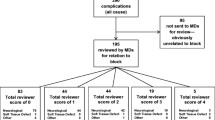Abstract
Background
The use of a tourniquet and patients’ preference for general anesthesia (GA) limit performing ankle blocks (AB) as a sole anesthetic technique for orthopedic foot surgery. The aim of this prospective and randomized study was to test the hypothesis that administration of an AB before GA could be effective for postoperative pain relief in patients undergoing outpatient hallux valgus surgery. Primary outcome measure was mean pain score and secondary outcome measures were time to mobilization of patients, time to hospital discharge, and complications.
Methods
A total of 110 adult patients were randomly assigned into two groups: group GA (n = 55) and group GA + AB (n = 55). Group GA + AB received an AB using 100 mg lidocaine 2% and 75 mg bupivacaine 0.5% before the induction of GA. Pain intensity was evaluated using a visual analogue scale (VAS).
Results
Mean VAS scores were higher and times to first rescue analgesic were shorter in group GA compared to group GA + AB (p = 0.001). More patients required rescue analgesic in group GA and pethidine consumption was higher (p = 0.001). Time to mobilization was shorter in GA + AB group (p = 0.001) but hospital discharge time was similar between groups (p = 0.269). The incidence of nausea and vomiting was higher in group GA (p = 0.002).
Conclusion
Ankle block is an effective and simple technique for reducing postoperative pain and opioid consumption. It reduced the time to mobilization without a delay in hospital discharge. It is concluded that the routine administration of AB before GA may be an effective and simple method for pain relief after foot surgery.
Zusammenfassung
Hintergrund
Die Anwendung eines Tourniquets und der Wunsch des Patienten für die Vollnarkose („general anesthesia“, GA) begrenzen die Durchführung von Fuβblockaden („ankle block“, AB) als alleinige Anästhesietechnik in der orthopädischen Fußchirurgie. Das Ziel dieser prospektiven und randomisierten Studie war es, die Hypothese zu überprüfen, dass Fuβblockaden vor der Vollnarkose effektiv für die postoperative Schmerzlinderung nach der ambulanten Hallux–valgus-Operation sein können. Primärer Endpunkt war der mittlere Schmerzscore. Sekundäre Endpunkte waren der Zeitpunkt der Mobilisation der Patienten, der Zeitpunkt der Entlassung aus dem Krankenhaus und Komplikationen.
Methoden
Insgesamt 110 erwachsene Patienten wurden in 2 Gruppen randomisiert: Gruppe GA (n = 55) und Gruppe GA + AB (n = 55). Die Patienten in Gruppe GA + AB erhielten vor der Induktion der Vollnarkose einen Fuβblock mit Verwendung von 100 mg Lidocain 2 % und 75 mg Bupivacain 0,5 %. Die Schmerzintensität wurde unter Verwendung der visuellen Analogskala (VAS) ermittelt.
Ergebnisse
Die mittleren VAS-Werte waren höher und der Zeitpunkt der ersten Rettungs-Analgetikum kürzer in der Gruppe GA als in der Gruppe GA + AB (p = 0,001). Mehr Patienten benötigten Rescue-Analgesie in der Gruppe GA und der Verbrauch von Pethidin war höher (p = 0,001). Der mittlere Zeitpunkt der Mobilisation war kürzer in der Gruppe GA + AB (p = 0,001), aber der Zeitpunkt der Entlassung aus dem Krankenhaus war nicht statistisch signifikant zwischen den Gruppen (p = 0,269). Die Inzidenz von Übelkeit und Erbrechen lag in der Gruppe GA höher (p = 0,002).
Schlussfolgerung
Der Fuβblock ist eine wirksame Technik, um postoperative Schmerzen und den Opioidverbrauch zu reduzieren. Er verkürzte auch die Zeit bis zur Mobilisation des Patienten, ohne Verzögerung der Entlassung aus dem Krankenhaus. Es kann geschlussfolgert werden, dass die routinemäßige Durchführung des Fuβblocks vor GA effektiv und einfach zur Schmerzlinderung nach einem fußchirurgischen Eingriff beitragen kann.


Similar content being viewed by others
References
Wülker N, Mittag F (2012) The treatment of hallux valgus. Dtsch Arztebl Int 109:857–868. https://doi.org/10.3238/arztebl.2012.0857
Adam F, Pelle-Lancien E, Bauer T, Solignac N, Sessler DI, Chauvin M (2012) Anesthesia and postoperative analgesia after percutaneous hallux valgus repair in ambulatory patients. Ann Fr Anesth Reanim 31(11):e265–e268. https://doi.org/10.1016/j.annfar.2012.07.022
Wang J, Liu GT, Mayo HG, Joshi GP (2015) Pain management for elective foot and ankle surgery: a systematic review of randomized controlled trials. J Foot Ankle Surg 54:625–635. https://doi.org/10.1053/j.jfas.2014.05.003
Flagg A II, Eng C, Mathur V Ankle block. From the web site of American Society of Regional Anesthesia. https://www.asra.com/pain-resource/article/46/ankle-block. Accessed: 16 Nov 2019
Aldrete JA (1995) The post-anesthesia recovery score revisited. J Clin Anesth 7:89–91.
Kir MC, Kir G (2018) Ankle nerve block adjuvant to general anesthesia reduces postsurgical pain and improves functional outcomes in hallux valgus surgery. Med Princ Pract 27(3):236–240. https://doi.org/10.1159/000488321
Su MP, Huang PJ, Tseng KY, Shen YC, Chen PN, Cheng KI (2019) Pretreatment of ankle nerve block provides better postoperative analgesia than peri-incisional local anesthetic infiltration in hallux valgus correction surgery. Kaohsiung J Med Sci 35:168–174. https://doi.org/10.1002/kjm2.12029
Foote J, Freeman R, Morgan S, Jarvis A (2012) Surgeon administered regional blocks for day case forefoot surgery. Foot Ankle Surg 18:141–143. https://doi.org/10.1016/j.fas.2011.07.003
Stein BE, Srikumaran U, Tan EW, Freehill MT, Wilckens JH (2012) Lower-extremity peripheral nerve blocks in the perioperative pain management of orthopaedic patients. J Bone Joint Surg Am 94:167. https://doi.org/10.2106/JBJS.K.01706
Jeon HJ, Park YC, Lee JN, Bae JS (2013) Popliteal sciatic nerve block versus spinal anesthesia in hallux valgus surgery. Korean J Anesthesiol 64:321–326. https://doi.org/10.4097/kjae.2013.64.4.321
Rudkin GE, Rudkin AK, Dracopoulos GC (2005) Ankle block success rate: a prospective analysis of 1,000 patients. Can J Anaesth 52(2):209–210. https://doi.org/10.1007/BF03027734
Author information
Authors and Affiliations
Corresponding author
Ethics declarations
Conflict of interest
M.Ö. Özhan, A. Tanrıöver, B. Atik, C. Özhan Çaparlar, B.M. Eşkin and A.M. Süzer declare that they have no competing interests.
Ethical standards.
All procedures performed in studies involving human participants or on human tissue were in accordance with the ethical standards of the institutional and/or national research committee and with the 1975 Helsinki declaration and its later amendments or comparable ethical standards. Informed consent was obtained from all individual participants included in the study.
Rights and permissions
About this article
Cite this article
Özhan, M.Ö., Tanrıöver, A., Atik, B. et al. Preoperative ankle block for postoperative analgesia in foot surgery. Anaesthesist 69, 565–572 (2020). https://doi.org/10.1007/s00101-020-00754-1
Received:
Revised:
Accepted:
Published:
Issue Date:
DOI: https://doi.org/10.1007/s00101-020-00754-1




